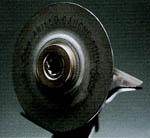Bronzes: Copper Alloys that Counter Friction
 The small, solid bronze thrust bearing supporting the rotating cutter blades of an Osterizer brand food blender. Friction inside many small consumer products, such as inkjet printers, is countered by inexpensive sintered bronze bearings.
The small, solid bronze thrust bearing supporting the rotating cutter blades of an Osterizer brand food blender. Friction inside many small consumer products, such as inkjet printers, is countered by inexpensive sintered bronze bearings.Cast and sintered bronzes perform an important anti-friction function in millions of American homes, automobiles and trucks, and in virtually all heavy industrial equipment. A familiar example is the common kitchen food processor. These machines use bronze bearings to smooth the motion of their whirling blades.
For centuries, bronzes have played a major role in combating friction. And bronze bearings continue to hold their own, in spite of long-time competition from ball, sleeve and roller bearings made of steel - and even those bearings may require bronze retainer rings.
Until early in the Industrial Revolution, bearings for vehicles and mechanical equipment were made of hardwoods. As more massive and faster-moving machinery was created, a stronger, longer-lasting bearing material was needed. Various bronze alloys were developed and are now used to make bearings in enormous variety for equipment from giant earth movers to kitchen blenders.
There are two basic ways to make bronze bearings: casting and sintering. Basic forms include: cylindrical sleeves or flanges; flat, donut-shaped thrust bearings; or disk-shaped bearing plates. Solid cast bearings are made from a variety of bronzes. For very demanding applications, William E. Austerberry, vice president of the National Bronze Mfg. Co., Detroit, recommends C95400, which contains 10% to 11.5% aluminum. This tough bronze has a tensile strength of 100,000 psi, nearly that of steel. It is also acid resistant. Although C95400 is very hard, hardened steel is slightly harder, so that the bronze is sacrificed, or worn, first. Parts that are either costly or difficult to replace are protected by these comparatively inexpensive bronze bearings which are expected to wear out over time and to be replaced periodically.
For less demanding applications, less costly C93200 is commonly specified. For applications involving high loads but low speeds, C90300, a tin bronze, referred to historically as Navy G, is recommended. "This strong material can stand repeated pounding," says Austerberry.
If corrosive salt water is present, then C92200, a medium-strength, free machining bronze that offers good brazing qualities, is the alloy of choice. Salt water will not corrode it. Where lubrication is doubtful, designers usually specify C93700, a general purpose bronze that offers low friction. It has good bearing qualities and can resist mildly corrosive acids, according to Austerberry.
C94500 is specified where lubrication may fail altogether; it contains 20% lead. Because it has a Brinell hardness of only 50, compared to 175 for high-strength C95400, it provides excellent conformity that corrects for minor misalignments.
Variety of Lubricants
Solid-cast bearings and bushings are often grooved by machining so can retain the lubricants needed at the surface bearing the load (See photo). The grooving varies depending on the shape of the bearing and the load conditions. Grooves are either circular, straight, looped, or in the shape of figure eights or double figure eights. The lubricants are either graphites pressed into the grooves under great pressure or mineral or petroleum-based oils flowing continuously. Graphite lubricants will usually last for the life of bearings.
When Sintered Is Superior
A variety of powders are compacted with bronze into sintered bearings, according to Dr. Vyacheslava Styskin, head metallurgist for the Wakefield Corporation, Wakefield, Massachusetts. There are even sintered bearings made entirely of iron. 'Although sintered iron bearings are stronger than all bronze bearings, the latter are superior for high-rotation-speed applications, such as in machine tools," according to Lee Sacks, general manager of Maryland Metrics, Baltimore. All the bearings from this vendor are made in metric rather than conventional sizes for manufacturers who export machinery or who use metric based machinery.
Sintered bearings don't require grooving because the lubricant is absorbed into the pores between the sintered groups of powder by vacuum impregnation or hours long immersion in hot oil. In general sintered bearings are used in lighter, shorter-product-life applications, such as desktop computer printers. Some sintered bearings are used dry in light-duty applications, according to Austerberry.
Lower-cost bimetal bearings with thin layers of bronze at the wearing surface are generally specified by cost-conscious engineers, such as those who design mass-produced items like auto engines, says Austerberry.
In Ball Bearings, Too
Low-friction ball and roller bearings with their many steel parts are more expensive than bronze bearings. Nevertheless, bronze plays an essential role in larger, heavy-duty ball or roller bearings; the retainer rings that hold the balls or rollers in position a-re made of bronze.
According to John Williamson, a salesperson with the Frank Tracy Company, New York, a major distributor of many brands of bearings, bronze is specified over steel for retainers because of its superior thermal characteristics in high heat environments.
National Bronze obtains its bronzes from a variety of sources, including Ampco, Bunting and Concast Metal Products. In addition to finished bearings, National Bronze also sells bar stock to a very small number of customers who make their own bearings.
Ampco: 414/645-3750
Bunting: 419/866-7000
Concast: 412/538-4000
Frank Tracy Company: 212/226-3500
Maryland Metrics: 800/638-1830
National Bronze Mfg. Com: 800/875-3558
Wakefield Corp: 800/548-9253
Also in this Issue:
- High Strength Copper Alloys Boost Injection Molding
- Bronzes: Copper Alloys that Counter Friction
- Copper Enhances Communications
- Copper Ensures More Hot Water
- Fashionable Facilities Count on Copper Cachet
